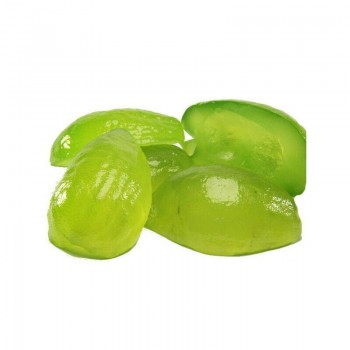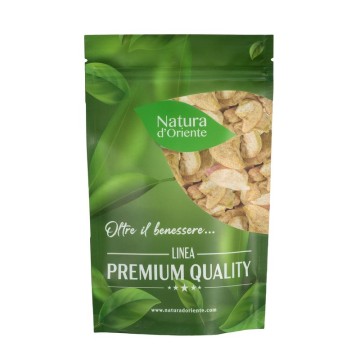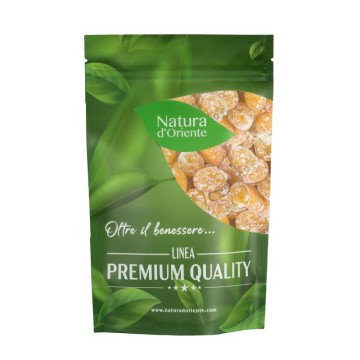Candied citron in cups
Candied citron is obtained from the peel of this fruit, which is caramelized in a syrup of water and sugar, to be sweetened and made "candied".
The peel is transformed into delicious soft and exquisite candied citron cups, which also have some benefits for our body.
Candied citron: properties and benefits
The cedar peel is considered beneficial at the digestive level, and its properties are present in the form of candied citron, even when immersed in sugar syrup and water.
As fruits, citrons have positive characteristics on our health thanks to the presence of vitamins, fibers and mineral salts they contain. Even in the peel, there are substances that fight digestive problems and disorders such as colitis, they help the well-being of the scalp.
We know that its rind is the largest part of the fruit, being very thick, and it is from here that the most beneficial extracts for our health come from.
The peel produces substances that promote digestive well-being, and have properties common to various citrus fruits, which in ancient times were used as disinfectants.
In large quantities, candied citron can have laxative effects, and is still protective for the stomach, colon and intestines.
The cupped candied citron peels include a good amount of vitamin C, as well as a high content of flavonoids, including hesperidin – studied for its contrasting potential to cholesterol and for the well-being of the cardiovascular system.
Many properties are attributed to the cedar on the beauty of the hair, and the peel of the cedar also contains bio-active compounds such as limonin, citral, iso- limonene, and various antioxidant terpenes.
The good amount of vitamin C gives beneficial properties for the immune system.
Cedar's known properties in ancient times were also soothing and relaxing, and it was used as a natural inflammation remedy to reduce redness and swelling.
Origins and History of cultivation
The cedar plant, known for millennia, is native to the foothills of the Himalayas and seems to have spread from Persia to the Mediterranean and the interior of Europe.
We know the fossil evidence of cedar cultivation in Ramat Rahel near Jerusalem, in a Persian garden.
It was often cultivated in gardens, in fact, being a rare plant and its diffusion continued over the centuries thanks to the magical and religious aura of its fruits - whose healing qualities were appreciated .
A great factor for its spread beyond Asia was caused by ease of preservation in travel, and therefore it easily arrived in Greece and ancient Rome. It took root easily in Italy, finding a favorable climate in the warmer areas.
Since ancient times cedar essential oil has also been used to give harmony to the body, and balance to the mind, and it indicated female fertility in some cultures, while in others it is a fruit linked to magic and wealth.
Cedar is currently grown mainly in the Mediterranean area, the Middle East, India, Australia, Brazil and the USA.
Plant and Fruit
Cedar is an evergreen fruit tree, the Citrus medica, belonging to the Rutaceae family). Together with pomelo and mandarin, it is considered one of the oldest citrus fruits.
Its shrub can reach 8 meters in height, with reddish branches and dark green leaves.
The flowers, very fragrant, are white while the fruits we know well are light green or yellowish.
The fruit of the cedar is about 25-30 centimeters large, round / oval, sometimes pointed on the opposite side of the peduncle.
The skin is very thick, as we have seen, and rough; it takes most of the fruit, which can be used more as a peel than as a pulp (about 30%).
Nutritional values of candied citron
Candied citron has more calories (about 300) than fresh, given the process of immersion in water and sugar syrup.
The peel contains little fat (approx. 0.2%), fiber (approx. 3%), calcium (approx. 55mg / 100g), sodium (approx. 27mg / 100g ).
This external part of the fruit contains vitamin C (about 2 mg / 100 g), and vitamins of group B and in particular vitamin B1, in addition to the different antioxidant compounds of which we mentioned (flavonoids, hesperidin, etc.).
How to consume candied citrons in cups in the kitchen or as a snack
The caramelized citron peels are transformed into a soft and sugary snack, they can also be used in the kitchen for the preparation of sweets and cassata, as well as as a snack.</p >
When you want to give a different touch to your dessert, candied citron is the ideal ingredient for taste and originality. It can also be added to soft doughs such as panettone (candied fruit are fundamental ingredients), or to plum cakes, cupcakes, muffins and ice cream.
Candied fruit is traditionally a component of pastry specialties such as cannoli.
Candied citron is excellent for flavoring herbal teas and teas, or added to yogurt. You can also prepare a fruit salad by inserting candied citron in cups, in a mix of cereals and dried fruit.
In some recipes, candied citron can be used to contrast tart flavours, and it can be added to drinks such as smoothies or drinks, to sweeten them. As for the orange, some candied citron peel in cocktails is spectacular.
Candied citron: side effects and contraindications
There are no contraindications to taking this candied fruit, even if the consumption of candied fruit is not recommended for diabetics. In fact, cupped citron contains more glucose and sucrose than fresh fruit, being candied in syrup.
In large doses, candied citron could cause a laxative action or cause acidity in the stomach.









 No reward points for this product.
No reward points for this product.
















![Natural dehydrated grapefruit without added sugar [NATURADORIENTE]](https://www.naturadoriente.com/10190-home_default/pompelmo-naturale-disidratato-senza-aggiunta-di-zucchero.jpg)